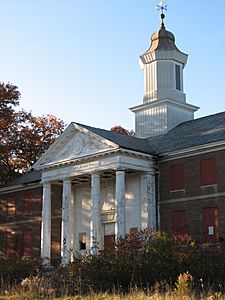Metropolitan State Hospital (Massachusetts) facts for kids
The Metropolitan State Hospital was a large public hospital in Massachusetts that helped people with mental health conditions. It was located across parts of Waltham, Lexington, and Belmont. Opened in 1927, it was once the biggest and most modern hospital of its kind in Massachusetts. The hospital closed in January 1992 because the state decided to move patients from large hospitals to smaller, community-based care settings. The main buildings have since been turned into apartments. In 1994, the hospital campus was added to the National Register of Historic Places, which recognizes important historical places. The property also included the Gaebler Children's Center, which cared for young people needing mental health support.
Quick facts for kids Metropolitan State Hospital |
|
|---|---|

Administration Building
|
|
| Geography | |
| Location | Massachusetts, United States |
| Organization | |
| Funding | Public hospital |
| Hospital type | Specialist |
| Services | |
| Speciality | Psychiatric hospital |
| History | |
| Closed | 1992 |
Contents
Hospital History
Building a New Hospital
The idea for the Metropolitan State Hospital came from a state law passed in 1900. This law said that the state should take care of people with mental health needs. Before this, local towns sometimes handled this care. Finding the right place for a new hospital in the Greater Boston area took a long time. This area needed more space for patients.
In 1926, the perfect spot was chosen. Construction on the hospital buildings began that same year. The hospital was officially opened in 1928, and patients started arriving on October 29, 1930. Building continued until 1935. Some parts of the construction were even overseen by the Works Progress Administration. This was a government program that created jobs during the Great Depression.
A Modern Facility
The entire hospital complex cost $1.8 million to build. At the time, it was thought to be the most modern mental health facility in the country. The hospital's design was very advanced for its time. It showed new ways of thinking about how to care for people with mental health conditions. Unlike older hospitals, it was built near roads, not just train lines. This showed how transportation was changing.
The buildings were designed in the Colonial Revival style by an architect named Gordon Robb. The outdoor areas were planned by R. Hayward Loring, following ideas from the famous Olmsted Brothers. At its busiest, the hospital cared for almost 2,000 patients. The grounds also had a cemetery called Met-Fern. This was a burial site shared with the Fernald School.
Hospital Closure
The Metropolitan State Hospital closed its doors in 1992. This was part of a bigger movement to change how mental health care was provided. Many state mental hospitals in Massachusetts closed around this time. The goal was to help patients live in smaller group settings within their communities. The property was empty for many years after the hospital closed.
New Uses for the Hospital Site
Turning Buildings into Homes
In 2007, some of the old hospital buildings were given a new purpose. The residential wards in the Lexington part of the property were turned into apartments. This was part of a larger apartment complex called Avalon at Lexington Hills. The Administration Building, which you can see in the picture above, is located in Waltham.
Several former hospital buildings were included in this new development. For example, the old Kline Hall now has marketing offices, a local TV station, an auditorium, and a fitness area. A large concrete artwork from the medical-surgical building was placed outside as a memorial. It helps people remember the history of the state hospital.
Open Space for Everyone
The large wooded areas around the former hospital are now open to the public. These areas are protected forever, meaning no more buildings can be built there. The trails in this area are part of the Western Greenway open space. This greenway connects to the Rock Meadow conservation area in Belmont to the east. There were also plans to connect it to the Middlesex County Hospital area to the west.

